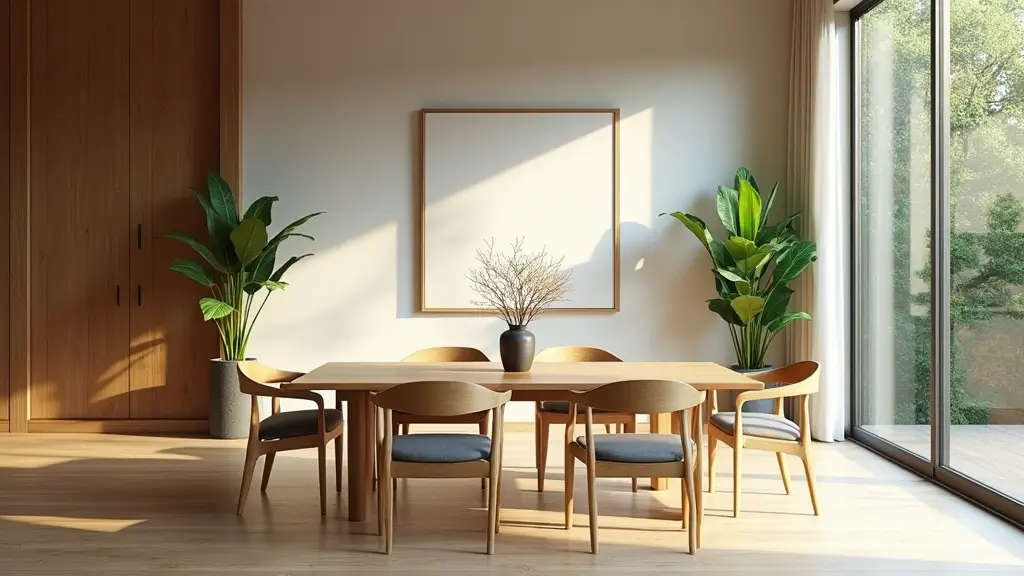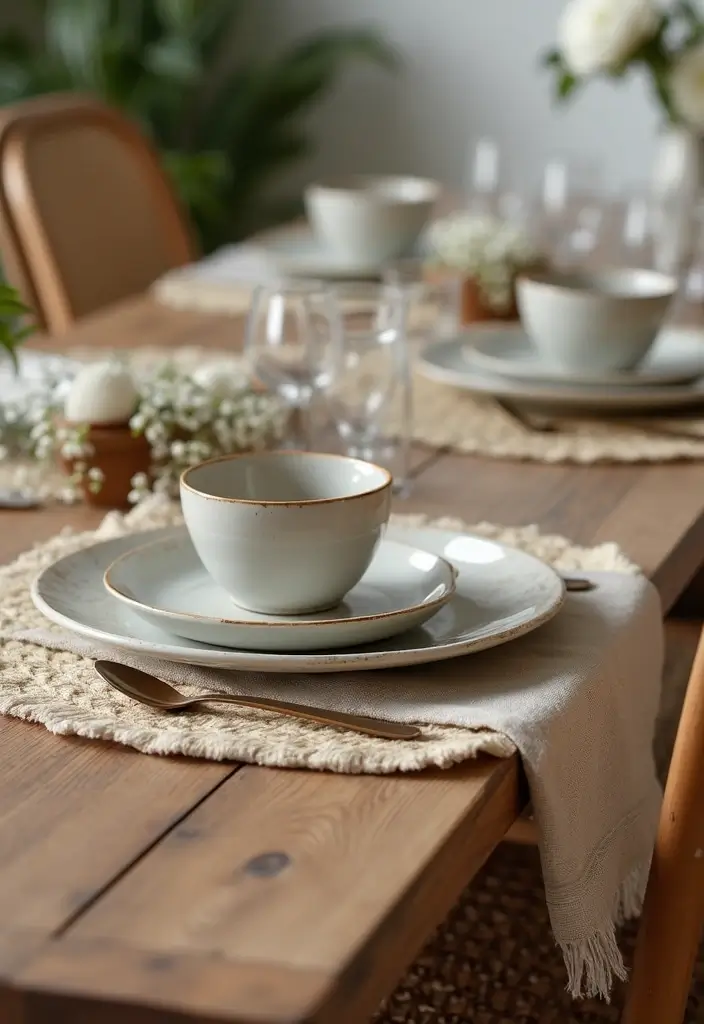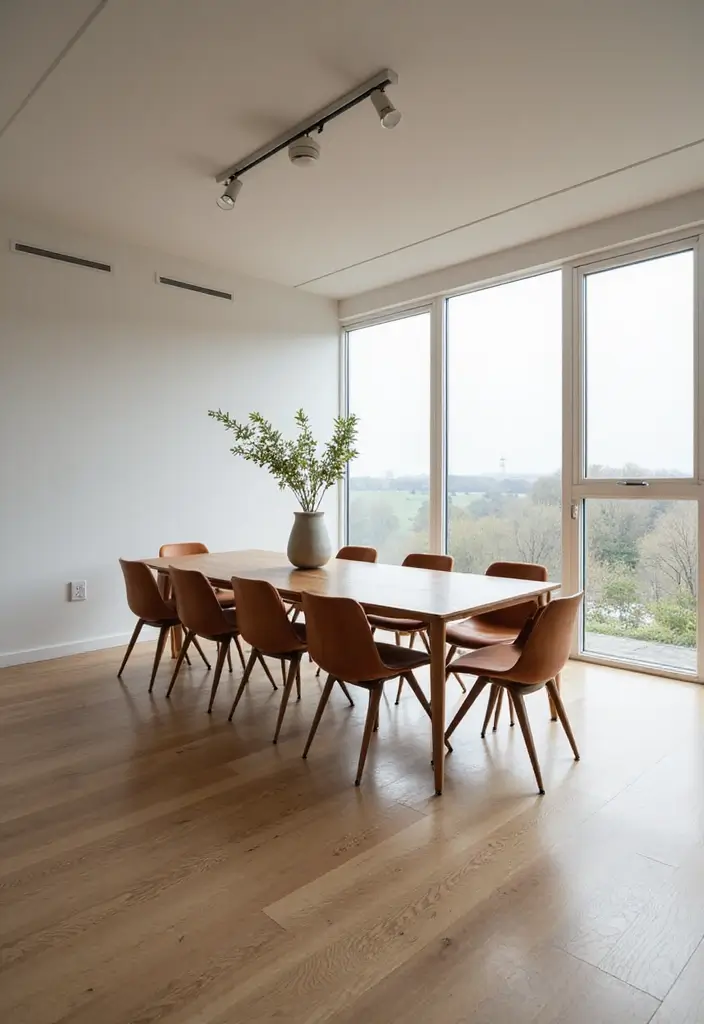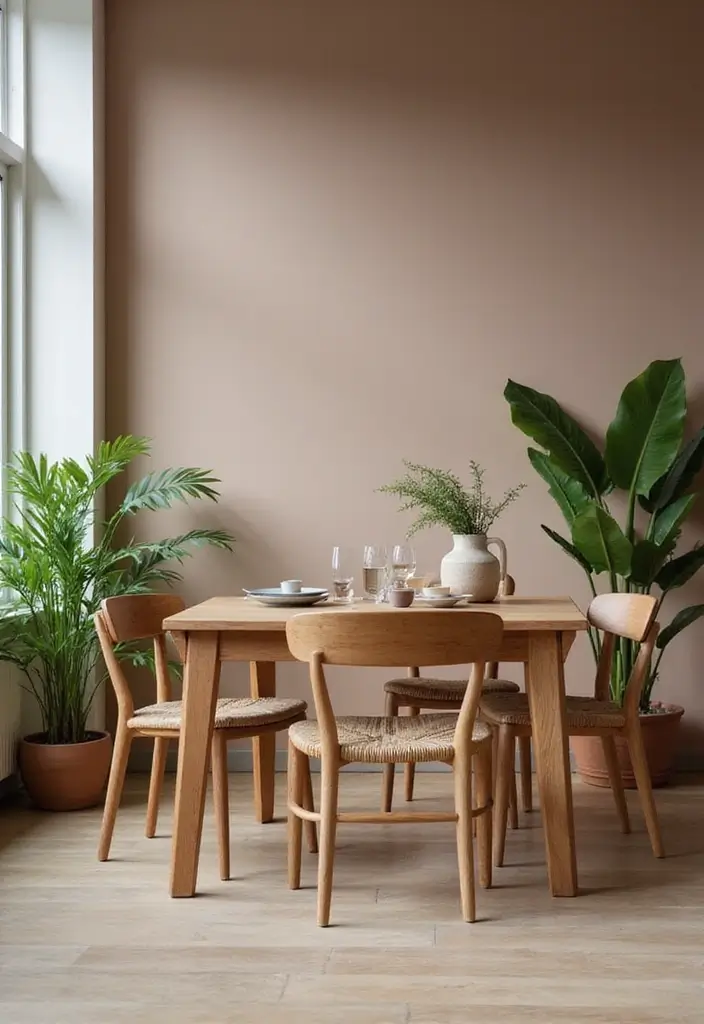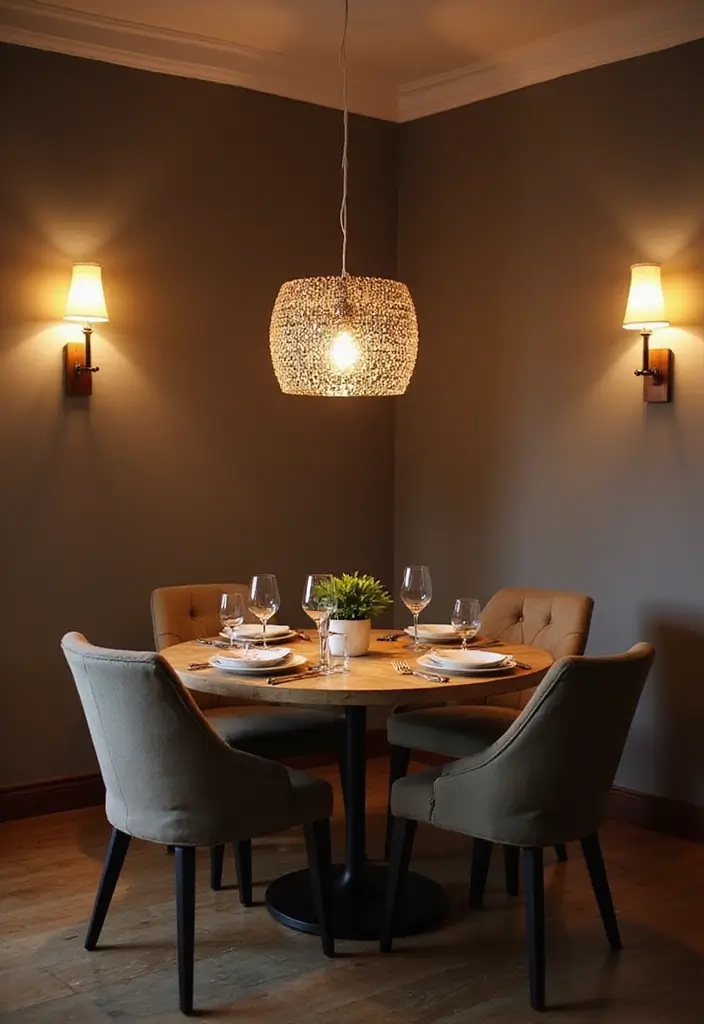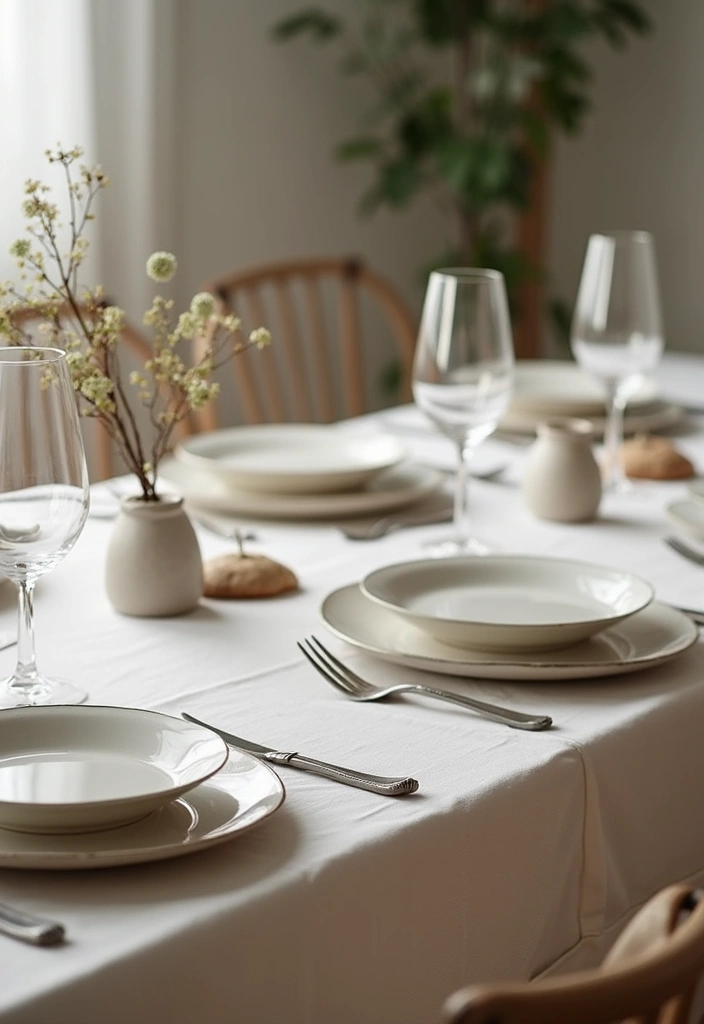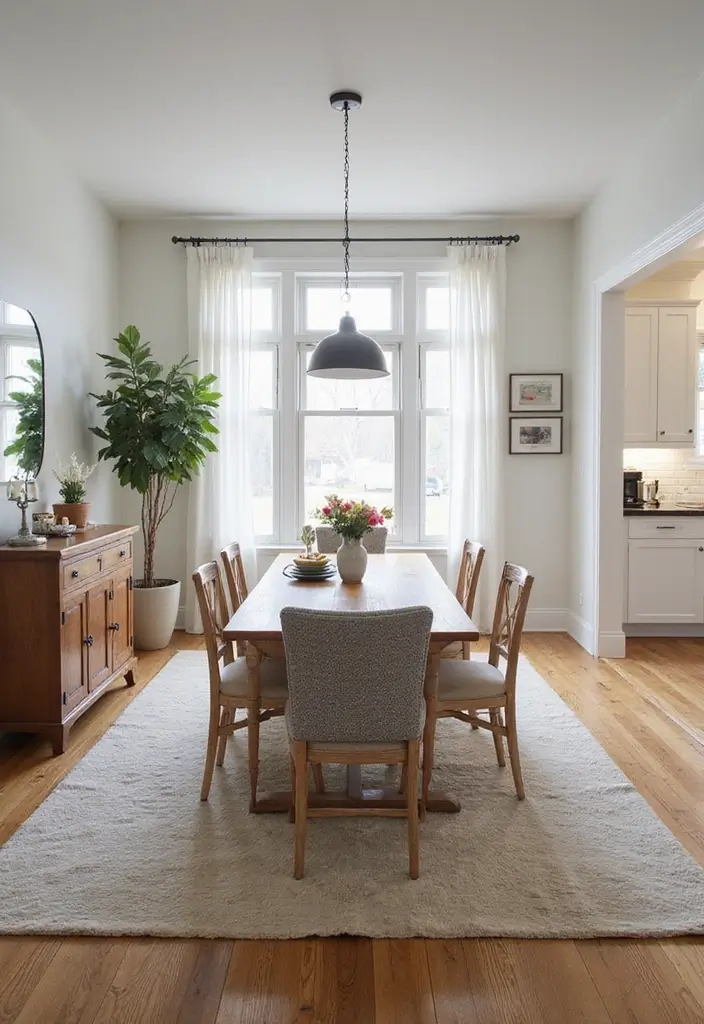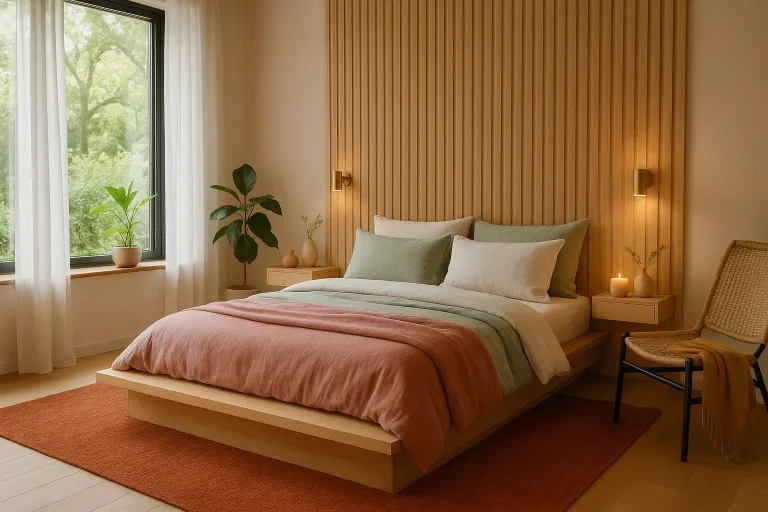How to Make an Open Space Japandi Dining Room Design That Maximizes Comfort and Style
Ever wonder why some dining rooms feel instantly calming? Japandi dining room design with Scandinavian warmth, creates serene, stylish spaces perfect for open-plan homes.
This style suits small apartments or spacious layouts, offering comfort without clutter.
You’ll learn how to use natural materials, neutral colors, and smart zoning to craft a dining area that feels cohesive and inviting, with practical steps drawn from 2025 design trends.
This guide breaks down clear, actionable steps to build your Japandi dining room. From choosing raw wood furniture to adding subtle greenery, each section addresses what to do, why it works, and how to make it yours.
You’ll find tips for small spaces, maintenance, and common pitfalls, ensuring a functional, beautiful result that enhances daily meals and gatherings.
1. Embrace Natural Materials
Natural materials define Japandi’s grounded aesthetic. Raw oak or walnut for tables and chairs brings warmth and durability, reflecting Japanese wabi-sabi’s love for imperfection.
Linen or cotton cushions soften the look, while ceramic serveware adds earthy texture.
These choices create a tactile, inviting space that feels timeless. Recent trends highlight raw wood for its organic appeal, popular in home design visuals for its authenticity.
For practical application, source furniture with natural finishes, like oak tables or rattan chairs. Refinish second-hand pieces for budget-friendly options, ensuring they’re free of synthetic coatings.
Pair with stone or clay accents for cohesion. Avoid plastic or glossy surfaces to maintain the style’s essence. Test textures in your space to ensure they complement existing elements.
- Select raw oak or walnut for tables and chairs for durability.
- Use linen or cotton cushions for soft, natural texture.
- Add ceramic bowls or stone coasters for earthy accents.
- Refinish second-hand furniture to align with Japandi style.
- Avoid synthetic materials like plastic to preserve authenticity.
2. Opt for a Minimalist Layout
A minimalist layout keeps your open-plan dining room uncluttered and functional. Center a low-profile table, allowing 3 feet of clearance for easy movement around it.
Round tables work best in smaller spaces (under 100 sq ft), while rectangular ones suit larger areas. Limit furniture to essentials, like a table, chairs, and one shelving unit, to maintain openness and flow.
Position the table near windows to enhance natural light, creating an airy atmosphere. Use a slim credenza or floating shelves for storage without crowding the floor.
Current home design visuals emphasize open layouts with sparse furniture, ensuring the dining area feels distinct yet connected in open plans. Check your space’s dimensions before selecting furniture to avoid overcrowding.
- Place the table centrally with 3 feet of clearance.
- Choose round tables for small spaces, rectangular for larger ones.
- Limit furniture to a table, chairs, and one storage unit.
- Position near windows for natural light and openness.
- Measure your space to ensure furniture fits comfortably
3. Choose Earthy Color Palettes
Earthy colors create Japandi’s signature calm. Soft beiges, warm grays, or off-whites for walls pair well with light oak or walnut furniture. Subtle contrasts, like muted greens or charcoal in textiles, add depth without disrupting serenity.
Recent design trends favor neutral-heavy palettes with dark accents, as seen in popular home decor visuals, for a balanced, modern look.
Test paint colors in your space’s lighting to ensure warmth, as artificial light can alter tones. Use natural wood tones for furniture to complement walls.
Avoid bright colors like red or yellow to keep the space tranquil. Incorporate textiles, like rugs or cushions, in muted shades to tie the palette together, ensuring a cohesive feel across the open plan.
- Paint walls in soft beiges, grays, or off-whites for calm.
- Use light oak or walnut for furniture to match neutrals.
- Add muted green or charcoal textiles for subtle contrast.
- Test paint samples in natural and artificial light.
- Avoid bright colors to maintain a serene atmosphere.
4. Integrate Functional Lighting
Lighting shapes the mood and utility of your Japandi dining room. Hang rice paper or linen pendant lights 30–36 inches above the table for a warm, intimate glow.
Matte black or brass wall sconces add ambiance without cluttering the space. Current trends highlight layered lighting, combining pendants and sconces for flexible moods, as seen in popular design visuals.
Choose energy-efficient LED bulbs (2700K) for warmth and longevity. Install dimmable switches to adjust light for casual or formal meals. Ensure fixtures match the table’s size to maintain proportion.
For maintenance, clean fabric shades gently to avoid wear. Check wiring safety before installation to prevent hazards, especially in open spaces with exposed fixtures.
- Hang pendant lights 30–36 inches above the table.
- Use matte black or brass sconces for extra ambiance.
- Select 2700K LED bulbs for warm, efficient lighting.
- Install dimmable switches for mood flexibility.
- Check wiring safety and clean fixtures regularly.
5. Add Greenery for a Fresh Touch
Greenery brings life and calm to your dining room. A small bonsai, fern, or snake plant in a ceramic pot adds organic texture without overwhelming the space.
Place plants near windows to catch natural light, enhancing Japandi’s biophilic appeal. Current visuals favor single plants or branches in vases for minimalist elegance, popular for their low-maintenance charm.
Choose low-maintenance plants if time or care is limited. Limit to 1–3 plants to avoid clutter, ensuring they complement the room’s neutral tones.
Dust leaves regularly for upkeep and check for overwatering to prevent damage to surfaces. Position plants strategically to avoid blocking walkways in open-plan spaces, maintaining clear movement paths.
- Select bonsai, ferns, or snake plants for low maintenance.
- Place plants near windows to maximize natural light.
- Limit to 1–3 plants to keep the space uncluttered.
- Dust leaves and monitor watering for plant health.
- Position plants to avoid obstructing walkways.
6. Accent with Art and Decor
Minimal decor adds personality without clutter. Choose one abstract print in a wooden frame or a hand-thrown ceramic vase for a subtle focal point.
Place decor asymmetrically to embrace Japandi’s imperfect balance. Trending visuals highlight single-statement pieces, like textured bowls with dried grasses, for their simplicity and elegance in dining spaces.
Select art with clean lines, such as ink wash paintings or Scandinavian line drawings. Limit to 2–3 items to preserve open space. Ensure pieces complement the room’s neutral palette and natural materials.
For maintenance, dust frames and ceramics regularly to keep them pristine. Avoid overloading shelves or tables to maintain the minimalist aesthetic in an open-plan layout.
- Choose one abstract print or ceramic vase for decor.
- Place decor asymmetrically for natural balance.
- Select art with clean lines to match Japandi style.
- Dust decor regularly to maintain a clean look.
- Limit to 2–3 items to avoid visual clutter
7. Comfortable Seating is Key
Seating blends style and comfort in Japandi dining rooms. Low-slung chairs with tapered wooden or rattan frames, cushioned with linen or wool, offer warmth and support.
Built-in benches with storage suit small spaces; stackable stools add flexibility. Current designs favor ergonomic seating for long meals, with mixed chair styles adding visual interest.
Ensure chair heights (17–19 inches) align with table height (29–30 inches) for comfort. Check furniture stability to avoid wobbling, especially for heavy use.
Clean textiles regularly to maintain freshness, using gentle methods for natural fabrics. In open plans, arrange seating to face the table’s focal point, keeping pathways clear for easy movement.
- Select low-slung wooden or rattan chairs with cushions.
- Use benches or stools for small-space flexibility.
- Ensure chair heights match table for comfort.
- Check furniture stability and clean textiles regularly.
- Arrange seating to keep pathways open.
8. Simplify Table Settings
Clean table settings reflect Japandi’s simplicity. Use neutral linen runners or placemats with ceramic plates and wooden cutlery for a natural look.
A single centerpiece, like a stone bowl or glass candleholder, adds elegance without excess. Visual trends highlight monochrome settings with textured serveware, such as bamboo, for their understated appeal.
Limit settings to 3–5 items per place to avoid clutter. Swap pieces seasonally, like lighter linens for warmer months, to refresh the look.
Clean ceramics and textiles after use to prevent stains, especially in open spaces where spills are visible. Ensure settings align with the table’s size and shape for a balanced, cohesive appearance.
- Use neutral linen runners and ceramic plates.
- Add a single stone or glass centerpiece.
- Limit settings to 3–5 items per place.
- Clean ceramics and textiles after use.
- Swap linens seasonally for a fresh look.
9. Create Zones in Open Spaces
Define your dining area in an open-plan layout without walls. A neutral jute or wool rug, extending 24 inches beyond the table, anchors the space.
Use a low credenza or floating shelves to separate the dining zone from kitchen or living areas. Current visuals use rugs and plants to mark boundaries while keeping the space open and connected.
Focus pendant lights over the table to reinforce the dining zone. Ensure walkways remain clear for easy movement, especially in high-traffic open plans.
Measure your space to confirm the rug and furniture fit without crowding. Regularly vacuum rugs and dust shelves to maintain a tidy, cohesive look across the open area.
- Lay a jute or wool rug to anchor the dining zone.
- Use a credenza or shelves to separate areas.
- Focus pendant lights to define the dining space.
- Keep walkways clear for easy movement.
- Vacuum rugs and dust shelves regularly.
10. Personalize with Your Style
Subtle personal touches make your Japandi dining room unique. Add a Japanese tea set or Scandinavian wool throw, keeping items minimal to avoid clutter.
Recent home design visuals suggest heirloom pieces, like a vintage tray or handmade ceramics, for sentiment with simplicity. Ensure personal items blend with the room’s neutral tones and natural materials.
Limit to 2–3 personal items to maintain Japandi’s clean aesthetic. For accessibility, consider adjustable-height tables for varied household needs.
Dust or clean personal items regularly to keep them fresh, especially in open spaces where dust is noticeable. Place items thoughtfully to enhance the room’s flow without disrupting its calm, open feel.
- Add a Japanese tea set or wool throw for personality.
- Limit to 2–3 personal items to avoid clutter.
- Choose adjustable-height tables for accessibility.
- Dust or clean items regularly for upkeep.
- Place items to enhance flow and calm.
Conclusion
Your open-space Japandi dining room can blend comfort and style effortlessly. Natural materials, minimalist layouts, and earthy colors create a serene foundation, while lighting, greenery, and decor add warmth.
Zoning ensures harmony in open plans, and personal touches reflect your style without clutter. Start with a key piece, like a wooden table, and build gradually, checking furniture stability and maintaining textiles for longevity.
Avoid common mistakes, like overcrowding or bright colors, to keep the space calm and functional. This design fosters mindful dining and lasting appeal.

